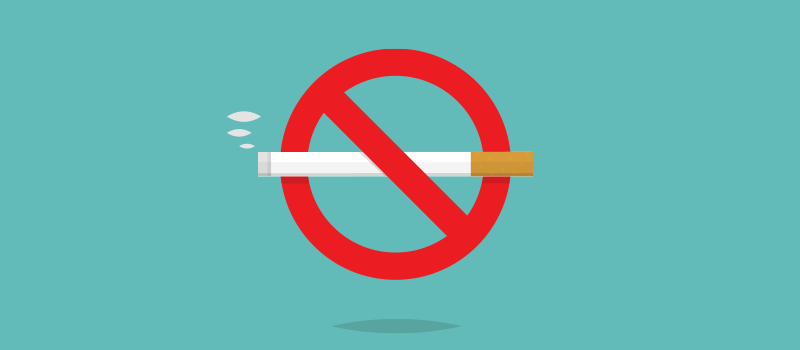What’s the Buzz
The Bee Healthy Blog
Causes of Lung Cancer in Non-Smokers

Lung cancer is the third most common cancer in the United States and a leading cause of death. More people die from lung cancer than any other type of cancer. The American Cancer Society estimates that some 235,000 new cases of lung cancer will be diagnosed in 2021 and there will be nearly 132,000 lung cancer deaths.
Tobacco smoking is the most common cause of lung cancer. However, some lung cancer patients are nonsmokers. While cigarette smoking and lung cancer rates have been declining, lung cancer in nonsmokers remains of interest because it is somewhat different from lung cancer among smokers.
Before we get into the causes and risks of lung cancer in nonsmokers, please note the difference between the terms non-smoker and never-smoker. A non-smoker is someone who does not currently smoke but has previously smoked more than 100 cigarettes in their lifetime. Never-smokers are people who have never smoked or have smoked fewer than 100 cigarettes in their lifetime.
What are the chances of a non-smoker getting lung cancer?
Smoking is the biggest risk factor for developing lung cancer. However, nonsmokers are not completely safe. Worldwide, approximately 25% of people diagnosed with lung cancer have never smoked. In the United States, roughly 19% of women and 9% of men with lung cancer are nonsmokers. As you can see, lung cancer in nonsmokers is more common in women.
Notably, lung cancer among people who have never smoked is different from lung cancer in current smokers or former smokers in terms of causes, treatments, targeted therapies, and survival rates.
What’s the difference between small cell lung cancer and non-small cell lung cancer?
Primary lung cancer starts in the lungs and can spread to other parts of the body. The two main types of primary lung cancer are called small cell lung cancer (SCLC) and non-small cell lung cancer (NSCLC). These names were given based on the appearance of the cancer cells when observed under a microscope. About 13% of all lung cancers are small cell lung cancers and 84% are non-small cell lung cancers.
It is rare (but not impossible) for never smokers to develop small cell lung cancer. Most nonsmokers are diagnosed with a type of non-small cell lung cancer called adenocarcinoma. On the other hand, smokers tend to develop a type of non-small cell lung cancer called squamous cell carcinoma.
How can you get lung cancer without smoking?
The development of lung cancer in nonsmokers and never smokers can occur due to various reasons, including exposure to secondhand smoke, air pollution, diesel exhaust, radon, asbestos, and certain harmful chemicals in the workplace.
Besides these known environmental risk factors, some people with lung cancer develop the disease for unexplained reasons. It could be due to genetics or random events without a known cause.
Lung cancers in nonsmokers can also occur in younger people who have certain genetic changes.
What are the main causes of lung cancer?
As noted, tobacco smoking is the leading cause of lung cancer. Around 8 out of 10 lung cancer deaths are caused by smoking. Many additional deaths are caused by exposure to secondhand smoke. The risk for lung cancer in smokers is many times higher than in nonsmokers. The more you smoke and the longer you smoke, the greater the risk.
Unfortunately, symptoms of lung cancer, such as shortness of breath or chest pain, are not usually present in the early stages, so lung cancer patients are often diagnosed after the disease has spread.
What are the causes of lung cancer in nonsmokers?
Environmental risk factors for lung cancer in nonsmokers include exposure to secondhand smoke, radon gas, hazardous chemicals, and air pollution. Carcinogens (cancer-causing substances) such as asbestos, heavy metals, and uranium can also cause lung cancer in nonsmokers and never smokers.
Genes play a role in the development of lung cancer in non-smoking people. Studies have shown that roughly 7 out of 10 nonsmokers with lung cancer have genetic mutations or alterations in specific genes.
Why is lung cancer increasing in nonsmokers?
Several risk factors can make it more likely for nonsmokers and never smokers to develop lung cancer.
Radon
According to the Environmental Protection Agency, radon exposure is the leading cause of lung cancer in nonsmokers. Radon is a naturally occurring radioactive gas in the atmosphere that you cannot see or smell. Very little radon is present outdoors and this is not dangerous. However, exposure to radon indoors can lead to lung cancer. Some buildings and homes may have high levels of this gas, especially in basements, so it is worth checking your home for radon
Asbestos
Another risk factor for lung cancer in both smokers and nonsmokers is asbestos exposure. This can occur in people who work in shipyards, textile plants, mills, mines, and places where insulation is used.
Carcinogens
Carcinogens (cancer-causing substances) in some workplaces can lead to the development of lung cancer in nonsmokers. This includes inhaled chemicals such as nickel and chromium compounds, mustard gas, coal products, vinyl chloride, silica, beryllium, cadmium, and arsenic. Radioactive ores like uranium and diesel exhaust are also known causes of lung cancers in never smokers and nonsmokers.
Dietary supplements
Certain dietary supplements can increase lung cancer risk in nonsmokers. Studies have shown that beta carotene (a precursor of vitamin A) can increase the risk of developing lung cancer.
Arsenic
In some parts of the world, such as South America and Asia, high levels of arsenic in drinking water have been found to increase lung cancer risk in both smokers and nonsmokers. However, these levels are several times higher than what is typically present in drinking water in the United States. Even in areas where arsenic levels are above normal, drinking water is not a major concern in the U.S.
Radiation therapy
One of the risk factors of lung cancer in nonsmokers and never smokers is radiation therapy to the chest or lungs, for example, in women who are treated for breast cancer after mastectomy or in people with Hodgkin disease.
Air pollution
Outdoor air pollution, for instance in areas with heavy traffic and diesel exhaust fumes, can slightly increase lung cancer risk.
Family history
Nonsmokers with a family history of lung cancer in a first-degree relative have a slightly higher risk of developing the disease themselves. It is not clear how much of this risk is genetic and how much is environmental (for example, due to shared household radon exposure or habits such as not avoiding secondhand smoke).
Smoking marijuana
Smoking marijuana can increase the risk of lung cancer in nonsmokers. Marijuana contains many of the same carcinogens that are present in tobacco smoke. Also, joints tend to be smoked all the way to the end where the tar content is highest. Deep inhalation of marijuana is common, allowing cancer-causing agents to be deposited in the lungs.
E-cigarettes
Some nonsmokers use e-cigarettes, which are an electronic delivery system for nicotine. They don’t contain tobacco but are classified as tobacco products by the FDA. It is unclear what the long-term risks of e-cigarette use might be and whether they can cause someone to develop lung cancer.
Talcum powder and talc
Talcum powder contains a mineral called talc. Cosmetic talcum powder use does not increase the risk of lung cancer. However, talc in its natural form may contain asbestos. Nonsmokers who work in talc mills and are exposed to industrial-grade talc may have a higher risk of respiratory diseases, including lung cancer.
References:
- https://www.cdc.gov/cancer/lung/statistics/index.htm
- https://amp.cancer.org/cancer/lung-cancer/causes-risks-prevention/what-causes.html
- https://www.yalemedicine.org/conditions/lung-cancer-in-nonsmokers
- https://www.ncbi.nlm.nih.gov/pmc/articles/PMC7431055/
- https://ar.iiarjournals.org/content/36/12/6207.abstract
- https://www.cancer.org/cancer/lung-cancer/about/key-statistics.html











SOCIAL